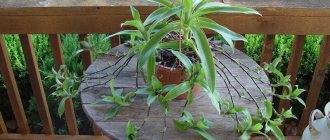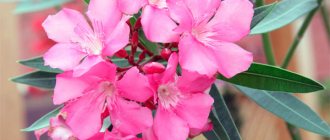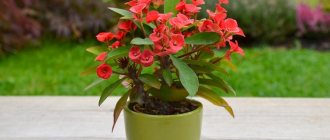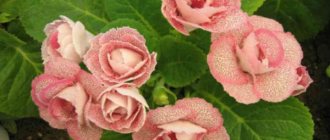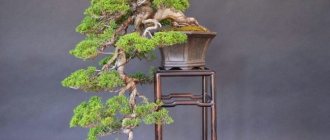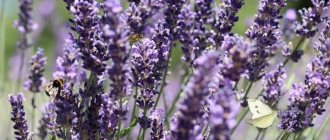Category: Succulents, Care Published 10/22/2018 · Comments: · Reading time: 10 min · Views: 1,876
The spiny shrub is considered by many to be a type of cactus with leaves, and its scarlet or pink bracts are mistaken for flowers. Euphorbia Mila is indeed, at first glance, a very unfriendly plant - its thorns are long and sharp, and with every uncertain movement they hurt painfully.
Among indoor euphorbias, the plant is the most attractive. Lovers of euphorbias claim that you can sculpt anything from it, be it a bush, a palm-shaped tree, or an elegant bonsai. Euphorbia Mila is surprisingly flexible and can be formed into any shape.
The bush comes from the island of Reunion next to Madagascar, even the name - Euphorbia milii - was given by the surname of its governor P. B. Milius, who brought the plant to France in 1821. Often in many sources its name sounds like Euphorbia Milius. The plant has other synonyms - beautiful spurge and brilliant spurge (Euphorbia splendens).
An interesting version exists regarding the popular name for milkweed Milya - “crown of thorns”. They say that in ancient times it was brought to the Middle East, where it spread en masse and formed real thorny thickets along roads, on the banks of rivers and streams, and in the tragic events associated with the crucifixion of Jesus, it served as its crown of thorns. How true this is remains to be determined by historians, but to contemporaries the plant is known as a decorative indoor flower, unpretentious and at the same time elegant and independent.
Botanical description of the plant
The perennial spurge shrub or Euphorbia Mila grows naturally in the mountainous regions of the island of Madagascar. In the wild, Mil's milkweed will grow up to 2 m.
Branched stems of grayish shades with numerous oval leaves, bright green. A special feature of Milk's milkweed is the large thorns that grow at the tips of the branches. The leaves gradually die off and are replaced by new ones, but the thorns remain forever.
During the growing season, a long stem grows from the top of the shoot, on which the inflorescences are located. Red, orange, white and pink bracts with dense rosettes, in the middle with small, inconspicuous yellow flowers. With proper care and lighting, Euphorbia Mili vulcanos blooms all year round.
Important! The leaves, shoots, flowers and rhizomes of Milkweed variety Milk contain white juice containing toxic substances.
Liquid getting into the eyes is especially dangerous, causing temporary blindness. If the juice comes into contact with skin, it may cause burns. Let’s find out whether it’s possible to keep an exotic flower at home.
Euphorbia milea features of growing at home
Mila is a tropical plant and it will not be possible to grow it on a personal plot. But at home it takes root well and blooms.
The plant is unpretentious in care, but is demanding in terms of lighting, air temperature and humidity . The home flower grows very slowly even if all the care rules are followed. The annual growth is from 2 to 3 cm. Therefore, to get a beautiful, spreading bush, you will have to be patient.
Whenever working with a home flower, be sure to wear gloves to help protect the skin from damage from thorns and burns.
Warning! If there are small children or animals in the house or apartment, the flower is placed in a place inaccessible to them.
How to care for a plant?
Lighting
One of the most important aspects in caring for milkweed is lighting. It should be optimally suited to the plant. Mila does not tolerate dark or shaded areas. Therefore, before you start this flower at home, you need to carefully select a suitable place for it. Euphorbia Milya feels great in direct sunlight. For a flower to grow well, it needs a lot of light.
Watering
Important! At home, the plant requires special watering and air humidity.
This species is drought-resistant. Since the flower grows in desert areas, it is accustomed to the scorching rays of the sun. And you should water it no more than 1-2 times a week.
Be sure to wait until the soil dries out and then carry out subsequent watering.
In winter, euphorbia rests, so the frequency of watering should be reduced. It is worth noting that this plant will tolerate dryness better than excessive moisture. Frequent and abundant watering leads to rotting of the roots. And complete drying of the soil threatens yellow leaves and their falling.
Euphorbia thrives in a dry room. This is a big plus for people who have a flower in their apartment. The only thing you need to do is ventilate it sometimes. Under no circumstances should you spray the plant, as water on the leaves leads to the formation and development of a fungal infection.
Temperature
The most important factor when growing Milk milkweed at home is temperature. The flower has a negative attitude towards sudden daily changes. The plant is very heat-loving. In summer, the air temperature should be at least +25 degrees. You can place the flower pot on the sunny veranda or balcony.
When cold weather sets in, the temperature should not drop by more than 10 degrees. Low rates are detrimental, as the root system of Mil's milkweed becomes overcooled and the flower dies.
Priming
This species is not at all picky about soil. Euphorbia can even grow in soil taken from the garden. However, it is recommended to buy special soil from a flower shop. Most often they take soil for cactus succulents.
To make the soil composition yourself, you will need:
- leaf soil (take 2 parts);
- sand (1 part);
- turf land (1 part).
Pot
The pot should be slightly narrowed and high. A quarter is covered with a drainage layer. Pebbles or expanded clay are suitable for drainage. The bottom of the pot should have large holes to drain excess moisture. Each subsequent pot for replanting a plant should be a couple of sizes larger.
Recommendation. Choose a pot that is proportionate - do not replant the flower in a pot of the same size.
Feeding
Complex preparations for succulents are often used. It is imperative to adhere to the dosage in accordance with the instructions. Feeding is mainly needed in the summer, when the plant is actively growing. Feeding is done only once a month
Be careful with nitrogen fertilizers! It’s better not to experiment and purchase a special composition for cacti
Trimming
How to prune plants to form a bush crown?
- It is worth carrying out this procedure after the spurge has faded.
- The pruning period is in autumn.
- First, the tops of the shoots are cut off.
- Then faded leaves and dry shoots are removed.
- A neatly shaped bush is formed.
- In the spring you can prune again.
- Renewed shoots are removed. This produces abundant flowering.
Transfer
In the first year of Mil's milkweed life, replanting is not done. Adult specimens are also not always replanted; this should be done when the roots do not fit in the pot. This procedure goes as follows:
It is necessary to carefully remove the flower from the pot along with a lump of earth. Next, the entire root system is cleaned. It is worth doing an inspection; if there are rotten roots, they need to be removed. The new pot is doused with boiling water. A drainage layer is poured and filled with earth. Then the earthen ball is placed in a new pot and covered with more soil on top.
We provide care at home
It is absolutely not necessary to look after the plant every day. Euphorbia Millie does not require close and constant care. But in order to get a beautifully flowering shrub, you will have to follow simple rules of agricultural technology.
Watch a video on how to care for milkweed at home.
What soil should I plant in?
In the wild, Mila grows on the rocky soils of a tropical island. To grow a flower at home, soil from the garden or a mixture made in equal parts from peat, fertile, loose soil and sand .
If it is not possible to prepare your own soil mixture, then soil for growing cacti from a flower shop is quite suitable for milkweed.
Choosing a location and lighting
on the south side of the room are most suitable .
Euphorbia loves sunlight. Only with good lighting will the bush grow and develop, and its lack leads to the elongation and thinning of the trunk and branches, the leaf plates turn yellow and fall off, and the flowering period does not occur.
Humidity and temperature
Maintaining temperature conditions is very important for growing milkweed Mil. With sudden changes in temperature, the flower goes into hibernation and stops developing.
The optimal climate conditions for cultivating exotic flowers are from +22 to +30 degrees. In the summer months, the pot with the plant is taken out to balconies, loggias or garden plots.
In winter, spurge feels great in heated rooms, even if the air in them is dry. The plant does not require high humidity, so euphorbia milii does not need additional spraying.
Dust from the leaves of the plant is wiped with a slightly damp soft cloth or brushed off with a brush.
Important! Euphorbia does not tolerate strong gusts of wind or drafts. When moving a flower pot outside, provide the plant with protection from the negative influence of the external environment.
How to water milkweed Mila
Winter and summer watering schedules for milkweed vary.
In its natural environment, the plant easily tolerates drought. At home, the flower requires abundant watering in summer and moderate irrigation in winter.
In the warm season, spurge is watered at least once every 5-7 days. But, at the same time, waterlogging of the soil leads to the development of fungal infections and the death of the plant.
Therefore, they wait until the top layer of soil dries out and only then water. Watering is carried out carefully, with warm, settled water, without getting moisture on the lower leaf plates.
In winter, the flower is watered based on the temperature and humidity in the room no more than once a month.
Important! If in winter the plant is located close to heating appliances or radiators, the soil dries out, and Euphorbia Milius sheds its leaves and loses its decorative characteristics.
When and what to feed milkweed
Although Euphorbia Mila is an unpretentious plant, it needs additional nutrients and minerals.
With the onset of spring, mineral complex fertilizers for succulents or cacti are added to the soil. Events are held no more than once a month and end in the fall. In winter, the flower does not need fertilizing or fertilizer.
Does the plant need pruning?
To ensure that the exotic plant always looks neat and lush, the crown of the bush is formed annually.
How to prune Mil's milkweed?
With the onset of spring, the longest branches of the bush are shortened by half. Such an event stimulates the growth of side shoots, the flower is leveled, becomes thicker and enters the active flowering phase.
Features of care
Unpretentious spurge only needs watering, provided the weather remains hot, as well as periodic loosening of the soil and fertilizing. This is enough to provide optimal conditions for flower growth.
Watering requirement
The first watering is carried out at the time of planting; for the first two weeks it is necessary to ensure that the top layer of soil does not dry out. Otherwise, the seedling may not take root.
There is no watering schedule; the procedure is performed when the soil dries out. In damp, rainy summers, you don’t have to water the plant at all. If the top layer of soil becomes whitish or cracks, it is loosened and at least 5 liters of water are added per bush.
The amount of water added must be controlled. Even slightly increased soil moisture causes the root system to begin to rot, and the process gradually spreads to the stems and leaves. This can be noticed when the flower becomes soft, individual shoots lie on the ground, leaves are pressed against the stems.
Feeding
Fertilizers are applied twice a month. Use mineral mixtures for succulents or complex compositions. Fertilizers for indoor plants are also suitable.
The first fertilizing with a break of 14 days is applied at the end of May and at the beginning of summer. If the soil is highly acidic, in addition to fertilizing, it is recommended to add lime to the soil.
Pests and diseases
Euphorbia is practically not susceptible to diseases. When the soil becomes waterlogged or there is a high moisture content in the air, rotting can begin, which weakens the immune system and leads to the development of bacteriosis and other diseases. But with proper care, this option is practically excluded.
If you find soft, dark, putrid spots on the leaves or trunk, stop watering and, if necessary, build a moisture drainage system from the area where the flower grows.
Pests also avoid spurge, but the plant is attacked by aphids. Its colonies are visible at the base of the trunk and on the underside of the leaves. Signs of damage include curling leaves, yellowing or lack of shoots, and an unhealthy appearance of the plant.
One of the natural ways to combat aphids is a soap solution used for spraying. Ready-made insecticides are also used - Fitoverm, Actellik.
Reproduction methods
Euphorbia reproduces in three ways:
- You can divide the bush in March-April, when the buds have just appeared, or in September, so that the plant has time to take root over the winter. You can divide it into any parts, but each of them must have at least one healthy kidney. During such a transplant, the flower regains its shape in 1-2 years.
- Dividing euphorbia by cuttings is much more effective, since an adult bush has many healthy shoots. You can select them both before flowering and after it. Before planting, place the cuttings in water to allow the juice to drain, dry the ends, stick them in open ground, and cover with cut plastic bottles.
- In spring, milkweed produces many seedlings. After they get stronger, they can be dug up and transplanted to a permanent place; this is best done in the fall.
When and how to replant a flower
When purchasing milkweed from a flower shop or garden center, do not rush to replant it in a new location. An exotic plant has a hard time surviving a change of permanent place of residence and any replanting measures .
In order for the flower to acclimatize in a new environment, wait 10-14 days, and only then transplant it to a permanent place of growth.
How to replant a plant: 1. Prepare a pot or flowerpot in advance, 3-5 cm larger in diameter than the previous one. 2. The container is scalded with boiling water , and a drainage layer of small stones or crushed stone is placed on the bottom. 3. The pot is filled with fertile soil and a deep hole is made. 4. Euphorbia is carefully removed from the old container along with the soil. 5. Place the plant with a lump of earth on the rhizome in a new pot. 6. The flower is covered with soil and lightly compacted. If necessary, water the plant.
The root system of young seedlings is actively developing and replanting is required annually. Adult flowers are replanted no more than once every 3-4 years.
Euphorbia - planting
Planting milkweed goes like this:
The pot must be chosen carefully and slowly
A particularly good solution would be, for example, a clay container, but plastic flowerpots would also be a good solution. Due to the fact that the roots of the plant do not grow much and have weak suction power, it is advisable to choose a low tub. It is important to ensure that the bottom of the pot is equipped with holes through which excess moisture can escape. Garden spurge is planted in the spring.
Soil for milkweed
It is best to buy soil for planting from a retail chain that offers products for indoor and greenhouse floriculture. In this case, it is allowed to use land prepared for cacti. You don’t have to rush to spend money, since it’s quite possible to make a soil mixture on your own: if you mix rotted leaves, sand and turf soil in equal quantities. To create a drainage layer, foam blocks, expanded clay and pebbles are used. The milkweed plant loves this kind of soil.
Safety precautions when growing and caring for milkweed Mile
Caring for homemade milkweed requires direct contact with the plant, the leaves, flowers, shoots and rhizomes of which contain toxic substances.
1. Before starting work, put on thick, protective gloves. 2. If plant sap accidentally gets on the skin, the burn site is thoroughly soaped and washed with running water, after which an antihistamine is taken. 3. If juice gets into your eyes, immediately rinse your vision with plenty of water and contact a specialist. 4. Once inside the body, the juice causes serious poisoning . Without waiting for the consequences, you should immediately consult a doctor.
Caring for milkweed Mil is not at all difficult and safe, if you do not neglect the simplest precautions.
Benefits and harms in the apartment
When purchasing white-veined milkweed, many people think about the question: is it possible to keep it at home? On the one hand, there are many superstitions that testify against this flower, on the other hand, there are many signs that speak in its favor.
Popular superstition prohibits keeping euphorbia in the bedroom of a young married couple: this will prevent the appearance of offspring. You also can’t place it in the bathroom, otherwise the water will take away the positivity from the house. Euphorbia in a children's room negatively affects the child's psyche and energy.
You can have different attitudes to folk beliefs, but you need to know why the poisonous juice of milkweed is dangerous. If it gets on the skin of the hands, it causes serious burns and can cause blindness if it comes into contact with the mucous membranes of the eyes. Doctors have recorded cases of poisoning that led to a coma. Therefore, it should be kept away from animals and small children who, out of curiosity, may taste the plant.
Did you know? In ancient India, poisoned arrows were made using milkweed juice.
However, it can also bring benefits. Traditional medicine knows the following properties:
- healing;
- anti-inflammatory;
- antiemetic;
- laxative;
- painkiller.
According to the Chinese teachings of Feng Shui, indoor white-veined spurge should be placed at the front door, which neutralizes negative energy and brings material well-being to the house. And a modern superstition says: keeping a plant in the office will help you make a career and will set up your work colleagues to have a positive attitude towards the owner of the flowerpot.
Methods of propagation of milkweed Mil
Euphorbia Mila is propagated by seeds, dividing the mother bush and cuttings.
Seed propagation method
To propagate a flower, buy milkweed seeds from a garden center or flower shop.
1. Before sowing seeds, prepare small containers with fertile soil.
2. Water the soil abundantly and lay the seeds on the surface. 3. The flowers planted on top are sprinkled with soil. 4. Containers with seedlings are covered with film and sent to a warm, dark place. 5. As soon as the first shoots appear, the film is removed and the pots are sent to a sunny place. 6. After 2-3 leaves appear, young shoots are planted in different pots.
When propagating a home flower by seeds, you must remember that the characteristics and properties of the mother variety will be lost.
Division by bushes
Typically, the procedure of dividing bushes is carried out when replanting plants. The adult flower is removed from the pot, and the rhizomes are thoroughly cleaned of the soil.
When dividing the bush, each plant should retain a developed root system and several shoots with vegetative buds and leaves.
The separated flowers are planted in different pots.
Propagation by cuttings
Propagation by cuttings is carried out in mid-spring. Watch a video on rooting milkweed cuttings.
To root cuttings: 1. The upper part of the strongest shoot measuring 10-12 cm is cut off from the mother plant. 2. The cutting is treated with an antibacterial agent and placed in a container with water. 3. As soon as a film forms at the cut sites, the cuttings are planted in fertile peat-based soil. If necessary, young plants are treated with a growth stimulator. 4. The planted flower is watered abundantly and placed in a warm, well-lit place. 5. After 12-16 days, the plant takes root and can be transplanted to a permanent location.
Important! When working with Mil's milkweed, do not forget about safety methods and protection from contact of toxic substances with the skin.
Which is correct?
For pruning, you can use a sharp knife or a special garden pruner. It is necessary to prepare sterile gauze wipes, charcoal and activated carbon. You should also take rubber gloves for circumcision so that the poisonous juice does not get on your hands.
- Rinse the knife or garden pruning shears well under water and wipe with alcohol (this is done to avoid infection during circumcision).
- To ensure that further growth of the stems is stopped, a sharp object must be heated.
- Put on gloves and, with careful movements, begin to trim the tops and side branches. To ensure that the plant does not grow too tall, the tops should be trimmed, and in order to prevent it from growing wider, you should control the number of side shoots, leaving the most beautiful ones that grow upwards and not to the sides .
- After circumcision, a specific juice appears, it is carefully wiped with a sterile cloth, and the cut area must be sprinkled with charcoal.
- Cuttings cut from the top shoots can be washed under warm water (so that the juice does not interfere with root regrowth), then air-dried for a couple of days and sprinkled with activated carbon to prevent rotting. Then root it in cactus substrate.
- After all procedures, be sure to wash your hands thoroughly with soap.
Prevention and treatment of diseases and pests of milkweed Milya
If the rules of agricultural technology are violated, Mil's milkweed is susceptible to fungal and viral infections. This means that the decorative characteristics of the exotic plant will also suffer.
The first sign of an unhealthy plant is yellowed, dropped leaves. If the rules of watering are violated, the rhizomes of the plants rot, which will subsequently lead to the death of the flower.
When damaged by fungi or viruses, dark spots appear on the milkweed. Prevention and treatment are carried out using professional preparations based on fungicides containing copper.
The toxic substances contained in the plant are harmless to most pests. Euphorbia Milya, if not properly cared for, is affected by mealybugs, whiteflies and aphids.
Aphid
When aphids infest the plant, the leaf blades become discolored and then fall off. If the pest is single, it is collected manually and destroyed. In case of massive damage to a flower, the plant is sprayed with professional solutions based on insecticides.
Whitefly
Whitefly, a small midge that spreads on the inside of plant leaves and shoots.
The pest feeds on the sap, gradually depriving the flower of vitality. If milkweed is not sprayed with insecticides in time, it will die.


